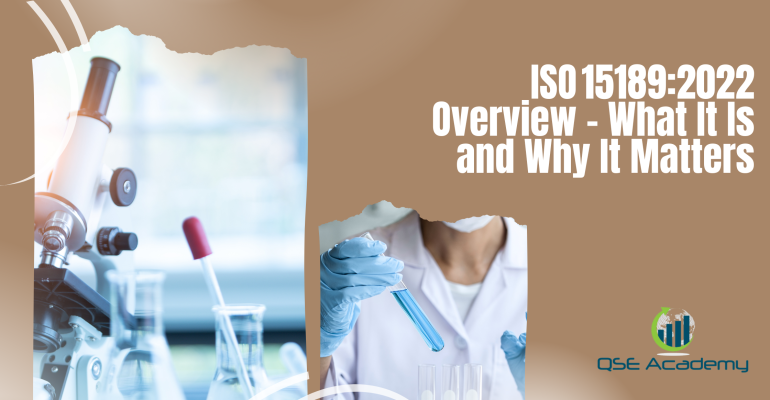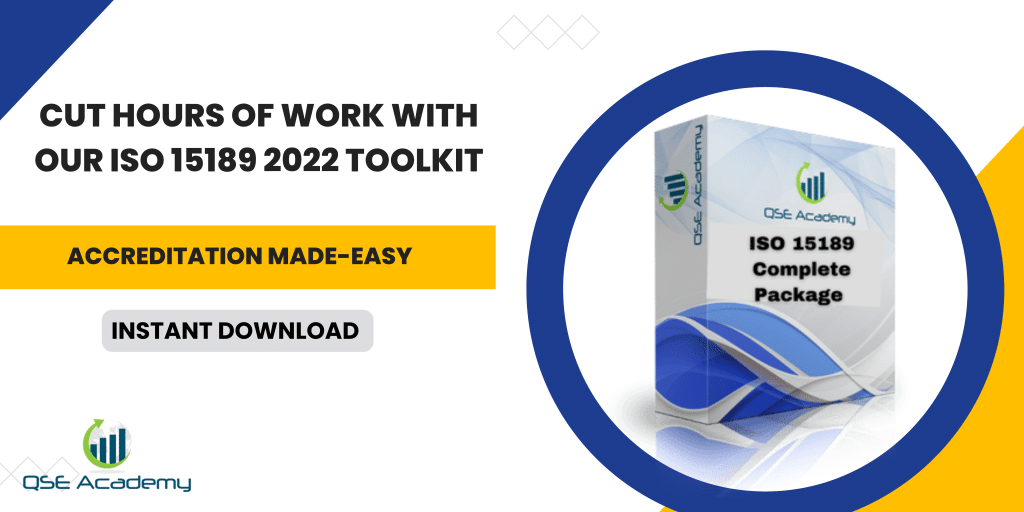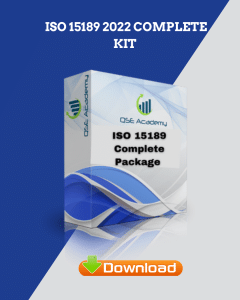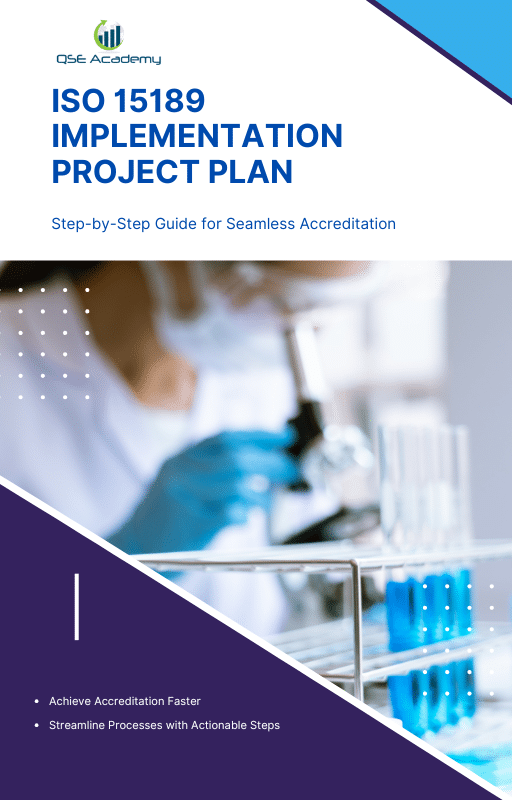ISO 15189:2022 Overview – What It Is and Why It Matters
Last Updated on October 22, 2025 by Hafsa J.
Setting the Stage for Quality in Medical Laboratories
In modern healthcare, laboratory results influence nearly every medical decision—from diagnosis to treatment and patient follow-up. Yet, the reliability of those results depends entirely on one thing: the competence and consistency of the laboratory itself. That’s where ISO 15189:2022 comes in.
ISO 15189 isn’t just another technical guideline—it’s the international gold standard that defines what quality and competence mean in medical laboratories. It establishes a framework that ensures every test result is accurate, traceable, and clinically meaningful.
This pillar article unpacks what ISO 15189:2022 is, how it evolved, and why it matters more than ever for clinical, hospital, and diagnostic laboratories. You’ll see how it shapes patient safety, strengthens quality systems, and connects your lab to global standards of trust.
By understanding this standard, you’re not just learning about compliance—you’re learning how to build a laboratory that delivers excellence every day.
Understanding ISO 15189:2022 – The Foundation of Laboratory Competence
At its core, ISO 15189:2022 defines what it means for a medical laboratory to be truly competent and reliable.
It brings together two essential aspects of quality: technical precision and systematic management.
On the technical side, it sets standards for equipment calibration, method validation, staff competence, and accurate reporting—everything that ensures each result can be trusted.
On the management side, it integrates principles of leadership, risk management, impartiality, and continual improvement, ensuring that quality isn’t just controlled, but sustained.
What makes ISO 15189 unique is that it bridges laboratory science and patient care. Every requirement—from document control to result verification—exists to protect patient safety and support clinical decision-making.
It’s not a static checklist; it’s a framework that evolves with your lab. When implemented well, it becomes the foundation for operational discipline, consistent performance, and medical credibility.
Pro Tip:
Think of ISO 15189 as the quality backbone of your laboratory. It doesn’t replace your daily routines—it strengthens them so that every test, every time, delivers dependable results.
What Changed in the 2022 Edition – Key Updates from Previous Versions
ISO 15189:2022 isn’t just a revision—it’s a modernized standard built to match today’s healthcare and laboratory realities.
The 2012 version served labs well, but the new edition takes a deeper look at risk, information, and continual improvement, aligning more closely with other ISO management standards.
Here are the most significant updates:
-
Alignment with ISO/IEC 17025 and ISO 9001:
The 2022 edition adopts the same high-level structure (Annex SL format), making it easier for labs to integrate with other quality or technical standards. -
Risk-Based Thinking:
The new version replaces prescriptive procedures with risk management principles. Labs are expected to identify, evaluate, and control risks that could affect result validity or patient safety. -
Information Systems & Data Integrity:
There’s now greater focus on digital systems, cybersecurity, and data confidentiality—critical as most labs move toward electronic reporting and LIS integration. -
Impartiality and Ethical Conduct:
The standard now explicitly requires management to prevent conflicts of interest and maintain professional objectivity. -
Continual Improvement:
Instead of static compliance, ISO 15189:2022 emphasizes a culture of learning and enhancement—each audit, review, or incident becomes an opportunity to refine operations.
Pro Tip:
If your lab was accredited under ISO 15189:2012, treat this transition as a strategic upgrade. The changes aren’t just about structure—they’re about future-proofing your lab for evolving technologies and patient expectations.
Core Principles of ISO 15189:2022 – What Makes It Different
ISO 15189:2022 stands out because it doesn’t just define what a laboratory should do—it defines how a laboratory should think.
The entire framework is built around a few key principles that shape how modern labs operate, improve, and earn trust.
Here are the foundations that set it apart:
-
Competence and Impartiality:
Every process, from sample handling to result interpretation, must be carried out by qualified staff under clearly defined responsibilities. Impartiality means no influence—internal or external—can compromise the accuracy of results. -
Patient-Centered Quality:
Every clause ties back to patient impact. The standard ensures that the results you produce are not only scientifically sound but also clinically meaningful. -
Evidence-Based Decision Making:
ISO 15189 requires you to use data—not assumptions—to improve quality. Metrics, audits, and trend analyses form the foundation for continual improvement. -
Risk-Based Approach:
Instead of prescribing fixed steps, ISO 15189 allows flexibility—provided you can demonstrate that risks to quality and patient safety are controlled and documented. -
Integration and Compatibility:
The structure mirrors other ISO standards, making it easier for labs to combine ISO 15189 with ISO 9001 (quality management) or ISO/IEC 17025 (testing competence).
These principles give the standard its strength—it’s adaptable, measurable, and universally relevant. Whether your lab runs a few dozen samples or thousands daily, these same principles build consistency and trust.
Scope and Applicability – Who Needs ISO 15189
ISO 15189:2022 applies to any laboratory that performs medical testing on human specimens, regardless of its size, structure, or ownership.
The standard’s goal is simple: to ensure that every test result issued by a medical lab is accurate, traceable, and suitable for clinical decision-making.
Here’s where it applies most clearly:
-
Private diagnostic centers offering specialized or routine testing services.
-
Public health laboratories supporting national surveillance and disease control programs.
-
Clinical research or reference laboratories generating data for medical studies and clinical trials.
Even non-traditional setups—like mobile testing units or labs integrated into telehealth platforms—can apply ISO 15189 to maintain consistent quality and patient safety.
It also connects naturally with other standards:
-
ISO/IEC 17025 covers general testing and calibration competence, while
-
ISO 9001 establishes broader quality management principles.
Together, they strengthen a laboratory’s overall quality framework.
Pro Tip:
ISO 15189 is fully scalable. Whether your lab runs thousands of samples daily or focuses on a single specialty, the same principles apply—the processes simply adjust to your scope.
Structure of the Standard – Clauses at a Glance
ISO 15189:2022 is organized into eight main clauses, each addressing a core part of how a medical laboratory should function. The structure balances technical accuracy with management discipline—so both science and systems work together to deliver quality.
Here’s a simplified breakdown:
| Clause | Title | What It Covers |
|---|---|---|
| 4. General Requirements | Impartiality, confidentiality, and ethical conduct. The lab must protect patient information and avoid conflicts of interest. | |
| 5. Structural Requirements | Leadership, organization, and responsibility. Defines how management and technical authority are distributed. | |
| 6. Resource Requirements | People, equipment, facilities, and information systems. Focuses on ensuring staff competence, proper maintenance, and suitable working environments. | |
| 7. Process Requirements | The heart of laboratory work: pre-examination, examination, post-examination, and result reporting. Emphasizes validation, verification, and traceability. | |
| 8. Management System Requirements | Quality management, risk control, document management, and continual improvement. Encourages labs to monitor performance and learn from nonconformities. |
Clauses 4 to 8 are tightly interconnected. Together, they ensure that laboratories don’t just produce results—they produce reliable, repeatable, and defensible results every single time.
Pro Tip:
Don’t view the clauses as separate checkboxes. They form one continuous cycle—inputs (resources), operations (processes), and oversight (management)—that drives your lab toward sustained excellence.
Why ISO 15189:2022 Matters – Real-World Impact
ISO 15189:2022 isn’t just a document of rules; it’s the difference between a laboratory that operates adequately and one that operates with purpose and precision.
Its value lies in what it delivers every day — safer patients, better data, and stronger credibility for the entire healthcare system.
Here’s why it matters:
-
Improved Diagnostic Accuracy:
Standardized processes mean fewer errors, validated methods, and more reliable results that physicians can act on with confidence. -
Patient Safety and Trust:
ISO 15189 links every requirement to clinical impact, ensuring that each specimen, test, and report protects the patient’s well-being. -
Operational Efficiency:
By reducing duplication, preventing nonconformities, and encouraging preventive action, the standard helps laboratories work smarter and faster. -
Global Credibility:
Accreditation under ISO 15189, recognized through ILAC-MRA, signals to regulators and partners that your laboratory meets international expectations. -
Staff Engagement and Accountability:
When roles are clear and procedures transparent, staff work with greater ownership and purpose.
Example:
A mid-sized hospital laboratory integrated ISO 15189 principles into its workflow and reduced turnaround times for critical results by 25 %. The gain wasn’t just technical—it rebuilt clinician confidence and patient satisfaction simultaneously.
In essence, ISO 15189:2022 matters because it transforms testing from a routine task into a system of measurable, trusted quality.
The Global Importance of ISO 15189
ISO 15189 has become the international language of medical laboratory quality.
Across continents, health authorities, regulators, and accreditation bodies use it as the benchmark for proving competence and reliability in clinical testing.
Here’s why it holds such global weight:
-
Worldwide Recognition through ILAC-MRA:
Laboratories accredited under ISO 15189 gain recognition across the International Laboratory Accreditation Cooperation (ILAC) network. This means test results issued in one accredited lab are trusted by other member countries without revalidation. -
Adopted by Health Systems and Ministries:
Many national health authorities—from Europe to Asia and Africa—require ISO 15189 compliance for clinical, research, or public health laboratories. It’s becoming the default standard for quality assurance in healthcare diagnostics. -
Supports Global Research and Clinical Trials:
Pharmaceutical sponsors, CROs, and research institutions rely on ISO 15189-accredited labs for their studies because it ensures data integrity, patient safety, and traceable results across borders. -
Builds Confidence in International Collaboration:
Whether it’s pandemic response, genetic testing, or cross-border sample exchange, ISO 15189 ensures that every partner trusts the data, regardless of origin.
Pro Tip:
ISO 15189 accreditation isn’t just about prestige—it’s about trust at scale. It allows your laboratory’s results to travel globally, opening doors to partnerships, funding, and scientific recognition that non-accredited labs can’t access.
Common Misconceptions About ISO 15189
Even with its global importance, ISO 15189 is often misunderstood. Many labs hesitate to begin their accreditation journey because of myths that make the process seem more difficult—or less relevant—than it really is.
Here are the most common misconceptions worth clearing up:
-
“It’s only for large hospitals.”
ISO 15189 scales to fit any lab. Small private clinics and specialized diagnostic centers benefit just as much as large institutions. -
“It’s too expensive.”
The investment is offset by efficiency gains, fewer reworks, and stronger client trust. Labs that adopt ISO 15189 often save more over time than they spend on implementation. -
“It’s just paperwork.”
Documentation is important, but it’s not the goal—it’s the proof. The system is about building reliability and accountability, not bureaucracy. -
“It’s a one-time certification.”
Accreditation is maintained through continual improvement and surveillance audits. The idea is to make quality part of the lab’s daily routine, not a one-off effort.
Pro Tip:
Understanding what ISO 15189 truly requires prevents wasted effort. When labs stop chasing checklists and focus on consistency, they discover that compliance naturally follows.
Getting Started – How to Prepare for ISO 15189 Accreditation
Beginning the journey toward ISO 15189:2022 accreditation doesn’t have to be overwhelming. The process becomes clear once you understand where you are, what’s required, and how to close the gaps systematically.
Here’s a straightforward way to begin:
-
Conduct a Gap Analysis
Assess how your current practices compare with ISO 15189 requirements. Identify what’s already in place and where improvements are needed—especially in documentation, risk management, and personnel competence. -
Develop or Strengthen Your Quality Management System (QMS)
Your QMS is the backbone of accreditation. Build policies, procedures, and records that demonstrate control, consistency, and traceability. Focus on clarity rather than volume—your system should work for your lab, not overwhelm it. -
Train and Engage Your Team
Every staff member plays a part in quality. Provide practical training on ISO 15189 principles, internal audits, and corrective actions so your team understands both their responsibilities and the purpose behind each requirement. -
Run Internal Audits and Management Reviews
These are your test runs before the formal accreditation assessment. Use internal audits to catch weaknesses early and management reviews to evaluate performance and allocate resources effectively. -
Plan for the Assessment
When you’re confident your system is functioning, contact an accreditation body for a pre-assessment or initial evaluation. Treat it as collaboration, not inspection—auditors are there to verify and strengthen your processes.
Pro Tip:
Start small if needed. Implement ISO 15189 in one department or testing area first, then expand across your lab. Early wins build confidence and momentum for full accreditation.
FAQs – Key Questions Answered
1. Is ISO 15189 accreditation mandatory?
Not everywhere. In some countries, it’s a regulatory requirement for medical laboratories. In others, it’s voluntary but strongly encouraged because it proves competence and builds trust with patients, physicians, and international partners.
2. How long does it take to achieve accreditation?
Most laboratories complete the process within 6–12 months, depending on their starting point. Labs already following structured quality practices can move even faster with proper guidance and internal commitment.
3. Can a small lab afford ISO 15189 accreditation?
Yes. The standard is scalable—both in cost and complexity. Small labs benefit the most from efficiency gains, improved organization, and client confidence that often lead to new business.
4. Does ISO 15189 replace national regulations like CLIA?
No. ISO 15189 complements national laws. CLIA ensures legal compliance within the U.S., while ISO 15189 provides international recognition of technical competence and quality management. Many leading labs hold both.
5. How often is accreditation reviewed?
Typically, accredited labs undergo annual surveillance audits to confirm continued compliance. Every few years, a full reassessment takes place to renew accreditation.
Pro Tip:
Use your surveillance audits as improvement opportunities, not checkpoints. Continuous learning keeps your lab’s system strong and future-ready.
Why Every Lab Should Care
ISO 15189:2022 defines what medical laboratory excellence truly means—competence, consistency, and credibility.
It’s more than a standard; it’s a shared language of trust between laboratories, healthcare providers, and patients.
Implementing ISO 15189 isn’t about impressing auditors. It’s about creating a culture where every test, every report, and every decision reflects quality. When your lab aligns with this standard, you’re not just meeting expectations—you’re setting them.
In an era where accurate results can mean the difference between life and loss, ISO 15189 ensures your lab delivers precision with purpose. It helps you minimize risk, build stronger teams, and gain recognition that extends far beyond your walls.
Pro Tip:
Don’t wait until you’re required to comply. Start now. Each improvement you make today under ISO 15189 moves your lab closer to excellence tomorrow.
Next Step:
If your laboratory is ready to begin or upgrade its ISO 15189 journey, QSE Academy provides structured toolkits, templates, and guided programs to help you achieve accreditation with confidence and clarity.
Whether it’s ISO 9001, ISO 22000, or the cosmetics-focused ISO 22716, I’ve spent my career I’m not here to call myself an expert—I prefer “enthusiast” because I truly love what I do. When I’m not writing about standards, you’ll probably find me playing Piano 🎹, connecting with people, or diving into my next big project💫. I’m an engineer specialized in the food and agricultural industry
make ISO standards less intimidating and more approachable for everyone.
turning complex jargon into clear, actionable steps that businesses can actually use.
There’s something incredibly rewarding about helping people navigate food safety and quality management systems
in a way that feels simple, practical, and even enjoyable.
I have a Master’s in QHSE management and over 12 years of experience as a Quality Manager
I’ve helped more than 15 companies implement ISO 9001, ISO 22000, ISO 22716, GMP, and other standards
My clients include food producers, cosmetics manufacturers, laboratories, and service companies
I believe quality systems should be simple, useful, and efficient.













